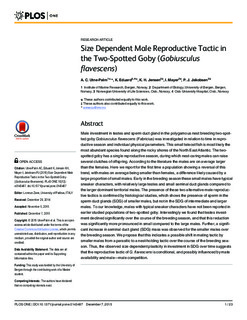| dc.contributor.author | Utne-Palm, Anne Christine | |
| dc.contributor.author | Eduard, Kjartan | |
| dc.contributor.author | Jensen, Knut Helge | |
| dc.contributor.author | Mayer, Ian | |
| dc.contributor.author | Jakobsen, Per Johan | |
| dc.date.accessioned | 2015-12-15T13:17:36Z | |
| dc.date.accessioned | 2015-12-30T08:55:55Z | |
| dc.date.available | 2015-12-15T13:17:36Z | |
| dc.date.available | 2015-12-30T08:55:55Z | |
| dc.date.issued | 2015-12-07 | |
| dc.identifier.citation | Utne-Palm AC, Eduard K, Jensen KH, Mayer I, Jakobsen PJ (2015) Size Dependent Male Reproductive Tactic in the Two-Spotted Goby (Gobiusculus flavescens). PLoS ONE 10(12): e0143487. doi:10.1371/journal.pone.0143487 | nb_NO |
| dc.identifier.issn | 1932-6203 | |
| dc.identifier.uri | http://hdl.handle.net/11250/2372310 | |
| dc.description.abstract | Male investment in testes and sperm duct gland in the polygamous nest breeding two-spotted goby Gobiusculus flavescens (Fabricius) was investigated in relation to time in reproductive season and individual physical parameters. This small teleost fish is most likely the most abundant species found along the rocky shores of the North East Atlantic. The two-spotted goby has a single reproductive season, during which nest-caring males can raise several clutches of offspring. According to the literature the males are on average larger than the females. Here we report for the first time a population showing a reversal of this trend, with males on average being smaller than females, a difference likely caused by a large proportion of small males. Early in the breeding season these small males have typical sneaker characters, with relatively large testes and small seminal duct glands compared to the larger dominant territorial males. The presence of these two alternative male reproductive tactics is confirmed by histological studies, which shows the presence of sperm in the sperm duct glands (SDG) of smaller males, but not in the SDG of intermediate and larger males. To our knowledge, males with typical sneaker characters have not been reported in earlier studied populations of two-spotted goby. Interestingly we found that testes investment declined significantly over the course of the breeding season, and that this reduction was significantly more pronounced in small compared to the large males. Further, a significant increase in seminal duct gland (SDG) mass was observed for the smaller males over the breeding season. We propose that this indicates a possible shift in mating tactic by smaller males from a parasitic to a nest-holding tactic over the course of the breeding season. Thus, the observed size dependent plasticity in investment in SDG over time suggests that the reproductive tactic of G. flavescens is conditional, and possibly influenced by mate availability and male—male competition. | nb_NO |
| dc.language.iso | eng | nb_NO |
| dc.publisher | Public Library of Science | nb_NO |
| dc.rights | Navngivelse 3.0 Norge | * |
| dc.rights.uri | http://creativecommons.org/licenses/by/3.0/no/ | * |
| dc.title | Size Dependent Male Reproductive Tactic in the Two-Spotted Goby (Gobiusculus flavescens) | nb_NO |
| dc.type | Journal article | nb_NO |
| dc.type | Peer reviewed | nb_NO |
| dc.date.updated | 2015-12-15T13:17:36Z | |
| dc.source.pagenumber | 23 | nb_NO |
| dc.source.journal | PLoS ONE | nb_NO |
| dc.identifier.doi | 10.1371/journal.pone.0143487 | |
| dc.identifier.cristin | 1300817 | |

